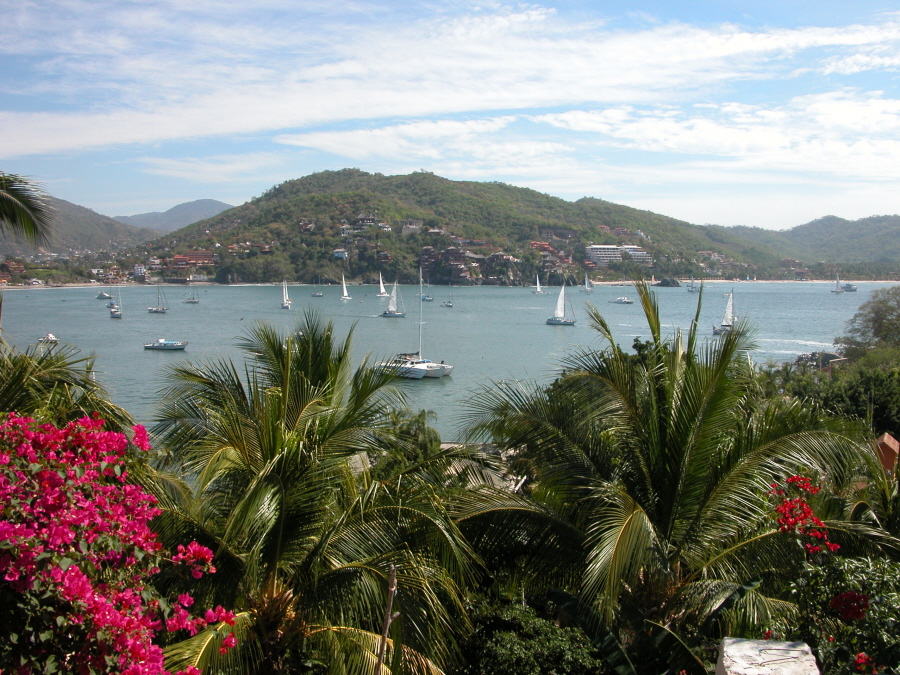
TO 'ZIHUA' AND BACK
Our southward travels along the Mexican Riviera ended at the city of Zihuatenejo [SEE-wah-ten-A-ho]. This shot was taken during the Zihua Sailfest, five days of special events organized by the foreign cruising boats to raise money for the local schools for indigenous children, many of whom do not speak Spanish, let alone English. Kavenga is at anchor on the far left, above the boat in the foreground with the blue roof.

 Our excuse for not being in the parade is that Steve
was still suffering from the effects of the fall he took while
painting the classrooms of one of the schools for which the money
was being raised.
Our excuse for not being in the parade is that Steve
was still suffering from the effects of the fall he took while
painting the classrooms of one of the schools for which the money
was being raised.
This shot was obviously taken before the fall. Dave on the powerboat, Megabyte was the photographer.
This is not the ladder that slipped out from under Steve. If he'd been on this ladder nothing would have happened. He had moved to the last classroom and the ladder there was a modern, aluminum extension ladder with plastic "feet". It was too tall to stand up in the room and could only be used at a somewhat shallow angle. Steve knew it was "twitchy" and had gone up and down it several times before.
But we were all rushing to finish up as our transportation was leaving in 15 minutes. Steve rushed up the ladder and, much as in the picture, was just about to apply the first brushstroke when the ladder suddenly slipped out from under him.
Steve did a hard "chest-flop" on the ladder and the concrete floor. He had the wind knocked out of him for half a minute, and suffered severely bruised ribs, muscles, tendons and cartilage, but it appears as of this date (May 1) that nothing was broken.
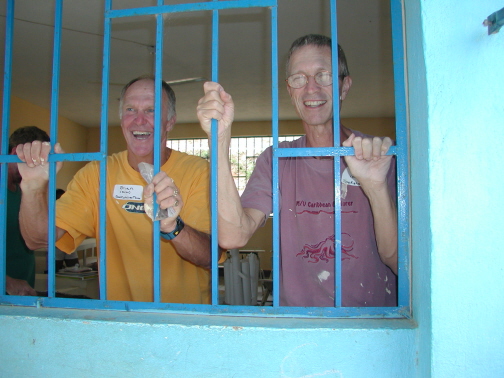
These two gentleman happened to be the closest to Steve when he fell. Coincidentally, the man on the left, Brian O'Neil of Shibui is a former aquaintance of Steve's from his Ship to Shore and West Marine days. The man on the right is Rich Crowell of Slipaway.
Brian talked Steve through his ordeal as he struggled to start breathing again. Rich had the unfortunate honor of catching Steve's pail of paint--the hard way--all over him. He kindly washed Steve's hat and sunglasses. (Photo taken before the accident).
The hardest part of the day was the bumpy ride back down to town in a Chevy Blazer. Each bump was like a sucker punch to the ribs.
Steve was boat-bound for a week and spent most that time flat on his back on the starboard settee.
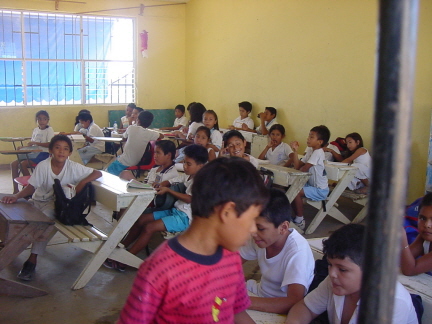
Here's one of the classrooms back in use after the painting project.
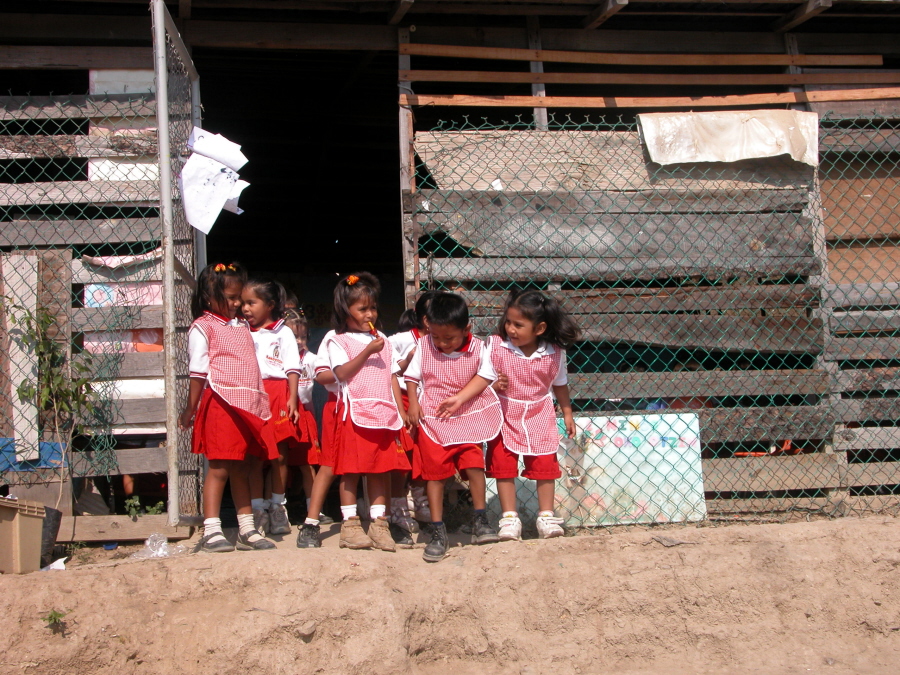
Just to give you an idea of how basic some of the schools are, here's a photo (above) of another one. The foreign cruisers went here to paint the chairs and desks rather than the classrooms, which, as you can see, are in need of walls capable of being painted.
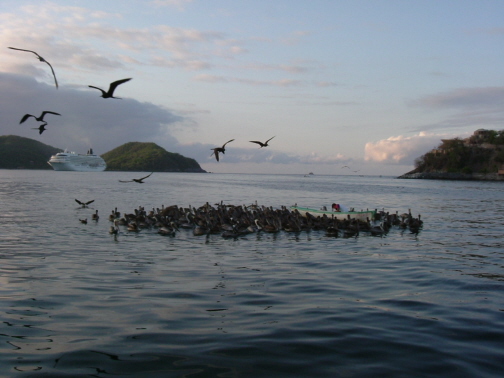
Both of us, but Kay in particular, were fascinated with the huge flocks of pelicans in Zihua.
She took this shot of perhaps 50 or more pelicans awaiting the rejects from a fisherman surrounded by them in his panga.
Frigate birds wheel overhead, hoping to steal a bite from a pelican or scoop something off the surface--they don't land in water like the pelicans.
A cruise ship sits at anchor off La Ropa Beach just inside the harbor entrance.
It is not uncommon in Mexico to see development projects that were abandoned even before completion. This is one of the more bizarre of those we have seen. The following pictures don't really do it justice. It was to have been a very upscale, exclusive housing/resort project. It was started by the brother of the former president of Mexico, Presidente Salinas de Gortari. There are paved streets, light poles, landscaping, half-completed houses and a beautifully designed swimming pool.
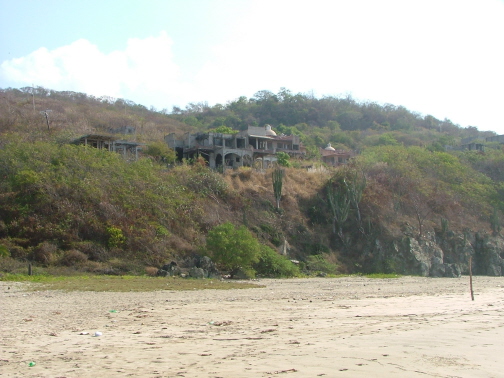

The houses are now just rotting hulks and the pool (just a small section of it), as you can see, is full of algae and who knows what.
At least some of the landscaping is still beautiful. We're standing in front of a large Bougainvillea bush on the left, and on the right is the icon of the tropics, the extravigant Hibiscus blossom.
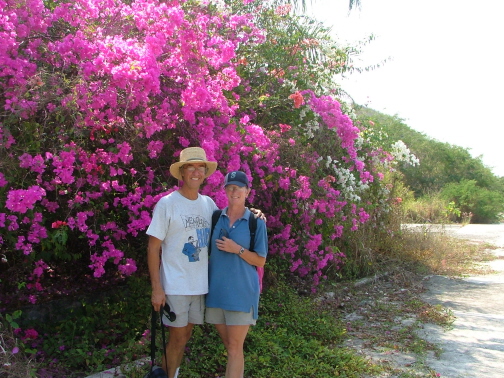
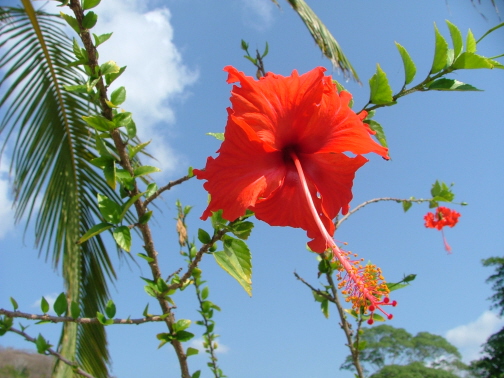
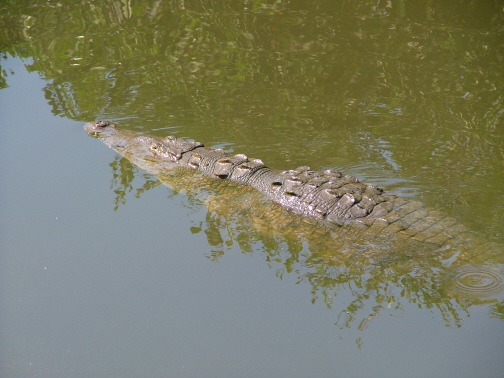
Some may be surprised to learn that crocodiles are present in the estuaries of the west coast of Mexico. South of Mazatlan, starting at about San Blas, the climate becomes increasingly tropical. Although their numbers aren't large, the crocs exist in many of the briny mangrove streams and they occasionally venture out into open water. Although we didn't see it, we were told by the crew of another boat that one about this size (7-8 feet) swam just astern of us when we were anchored off Playa la Ropa. Since we had just spent three hours in the water scrubbing Kavenga's bottom, we were glad we hadn't known about this beforehand.
This guy was one of several that we spotted in the estuary that enters the ocean at Playa Linda near the resort town of Ixtapa, a few miles north of Zihuatenejo.
Diving for bottom cleaning or underwater hull repairs are not allowed in the Ixtapa Marina due to the large number of crocs in the area.
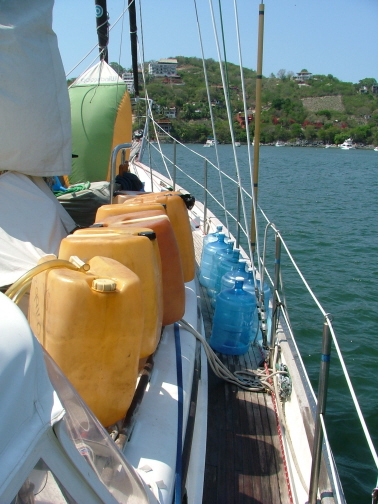
After staying several weeks longer than planned, it was finally time to leave Zihuatenejo. The bottom had gotten badly fouled again due to the rapid growth of barnacles, sponges and a vast assortment of other marine life. We had cleaned the bottom ourselves a month earlier but that was before Steve's fall and before we learned about the crocs. So we had a local do it and it was well worth what we paid him.
We also needed to take on fuel and water. We have yet to miss the watermaker we had on our 1991 trip. Shortly after arriving in Zihua we caught 100 gallons of rainwater in a brief but heavy shower. This topped off our tanks and lasted us until it was time for us to leave. Then it was quite easy to order diesel and purified water from Ishmael, a local entrepreneur who delivers provisions to boats as well as beach businesses without road access.
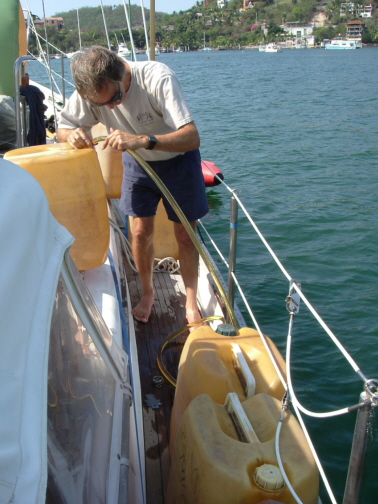
Here is Steve, having loads of fun siphoning diesel out of Ishmael's jerry cans into our tanks. There is a fuel dock in Zihua, but that requires taking in a badly fouled anchor chain and going to a rough dock that isn't attended 100% of the time, so the small hassle of having to siphon out of the 14-gallon jugs was worth it.

Here's a final look at Zihuatenejo as we head out.
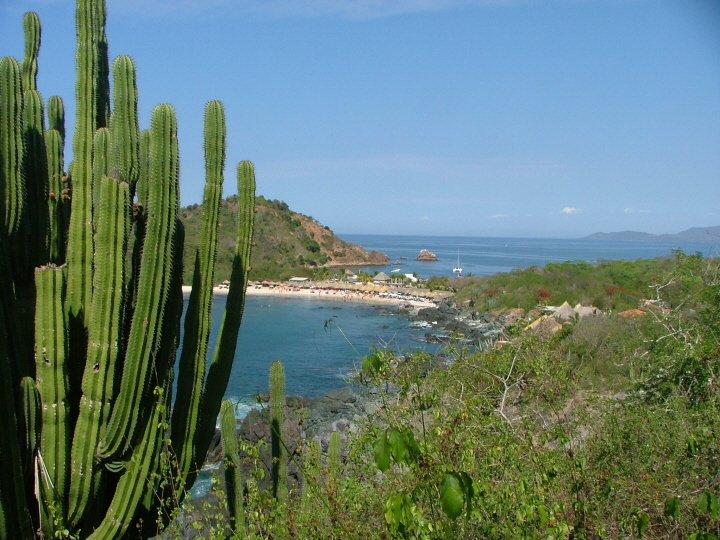
Our leg heading back north was a short one, only about nine miles or so to Isla Grande. It's a small island just offshore of Ixtapa.
Pangas bring tourists out to the island from Ixtapa every morning to snorkel, hike or just lie in the sun with a beer or a margarita.
Kavenga is anchored just out of sight not far from the catamaran visible on the far side of the narrow isthmus that connects the two halves of the island.
We snorkeled near the rocky islet in the distance and saw many tropical fish we had not even seen in the South Pacific.
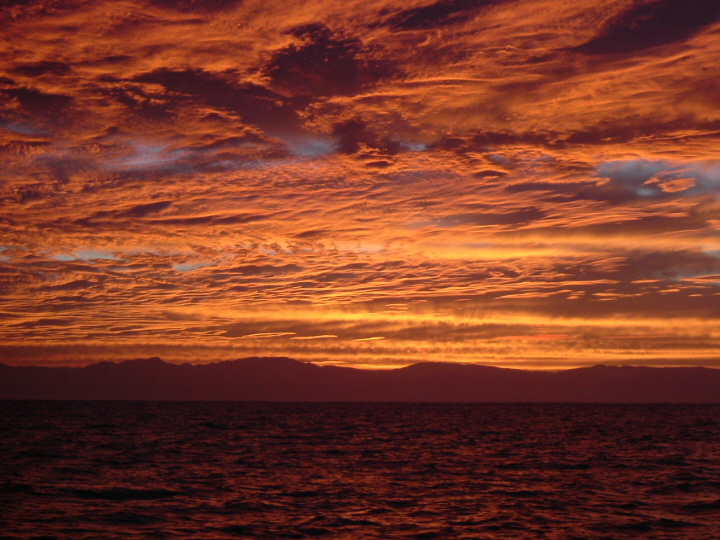
This was one of the better sunrises we saw as we retraced our track back north.
We made stops at Lazaro Cardenas, Caleta Carrizal, Barra Lagoon, and Tenacatita before arriving in our most familiar port in Mexico, Puerto Vallarta, the subject of our next page.